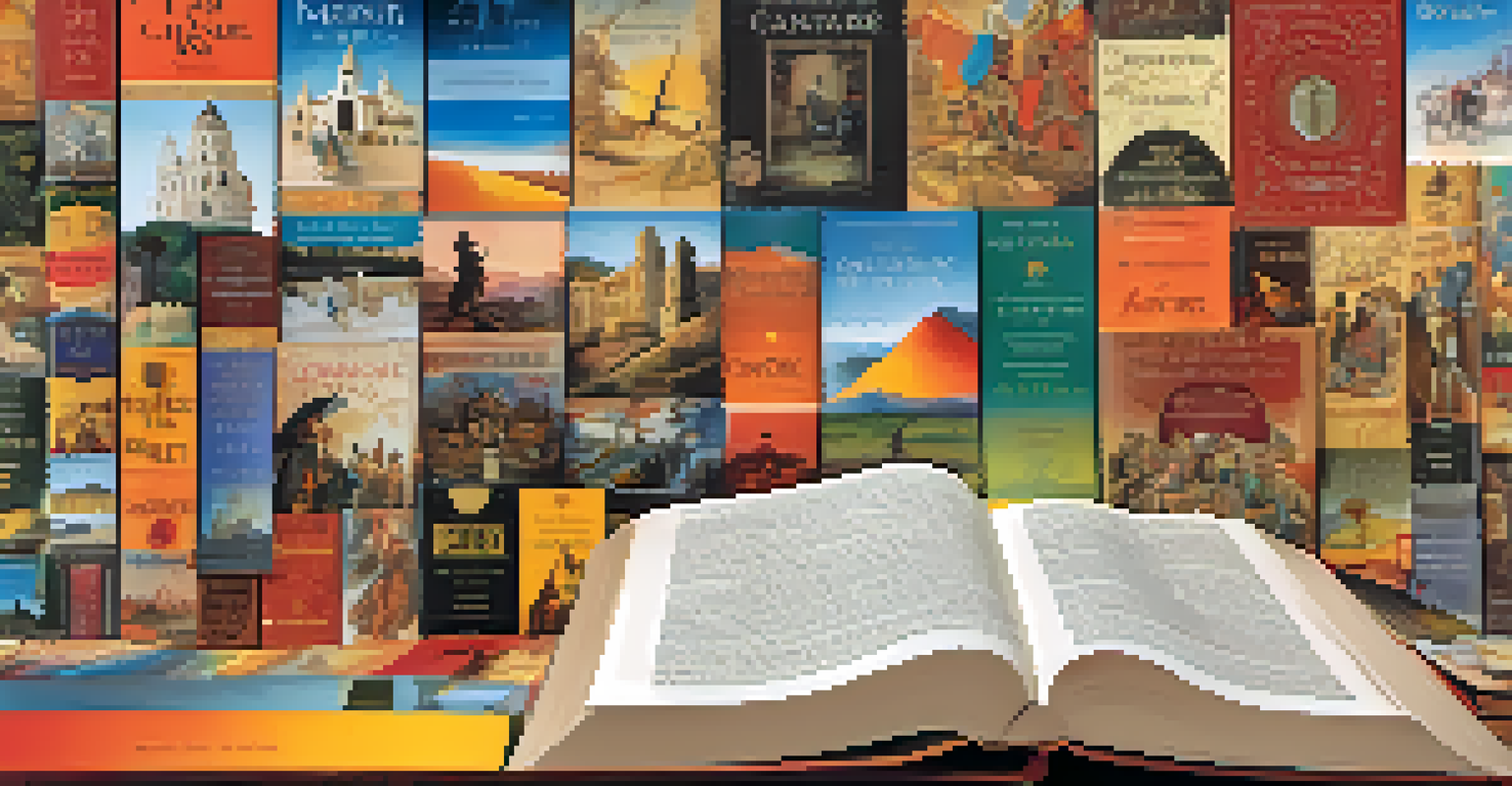The Influence of Spanish Literature on Global Culture

The Roots of Spanish Literature in Culture
Spanish literature has deep roots that intertwine with the country's rich history and cultural identity. From medieval texts to the Golden Age, these works reflect the societal values, struggles, and triumphs of their times. This literature serves as a mirror, not just of Spain, but of the broader European landscape, influencing how stories are told and understood.
Literature is a way of keeping a record of human experience and a way of expressing the complexities of life.
For instance, the epic poem 'Cantar de los Cantares' highlights themes of love and loyalty, resonating with audiences across cultures. These early works laid the groundwork for later literary movements, showcasing the power of storytelling to transcend borders. The historical context in which these texts were written offers valuable insights into the evolution of European thought and culture.
Thus, Spanish literature stands as a testament to the intertwining of history and narrative, influencing not only Spanish-speaking countries but also the global literary scene.
Cervantes and the Birth of the Novel
Miguel de Cervantes' 'Don Quixote' is often hailed as one of the first modern novels, marking a pivotal moment in literary history. This work's complex characters and innovative narrative style broke the mold of previous storytelling, setting a standard for future writers around the globe. Cervantes' exploration of themes like reality versus illusion resonates with readers even today.

The character of Don Quixote himself has become a cultural icon, symbolizing the struggle between idealism and pragmatism. His adventures have inspired countless adaptations in various forms, from theater to film, showcasing literature's ability to evolve and adapt. Cervantes’ impact extends beyond literature, influencing art, philosophy, and popular culture.
Spanish Literature's Cultural Roots
Spanish literature reflects the country's rich history and cultural identity, influencing global storytelling.
Through 'Don Quixote,' Cervantes not only changed the course of Spanish literature but also laid the groundwork for the modern novel worldwide, illustrating the profound interconnectedness of cultural narratives.
The Golden Age: A Flourishing of Voices
The Spanish Golden Age, spanning the late 15th to early 17th centuries, was a vibrant period of literary production. Writers like Lope de Vega and Calderón de la Barca brought forth a wealth of plays and poetry that explored human emotions and societal issues. Their works still resonate today, showcasing themes of love, honor, and conflict that are universally relatable.
The only way to deal with the future is to function efficiently in the now.
This era also saw the rise of women writers such as Sor Juana Inés de la Cruz, whose literary contributions challenged societal norms. Her works highlighted the intellectual capabilities of women, paving the way for future generations of female authors. The diverse voices of the Golden Age not only enriched Spanish literature but also influenced global narratives around gender and power.
The legacy of this period continues to inspire contemporary writers, proving that the themes explored during the Golden Age remain relevant in today's literary landscape.
Influence on Latin American Literature
Spanish literature has significantly shaped the literary traditions of Latin America, creating a rich tapestry of voices and styles. The works of authors like Gabriel García Márquez and Julio Cortázar draw on Spanish literary traditions while infusing their narratives with local culture and folklore. This fusion has resulted in the unique genre known as magical realism.
Through their storytelling, these authors have addressed social and political issues, reflecting the complexities of Latin American identity. For example, Márquez’s 'One Hundred Years of Solitude' intertwines personal and political histories, making it a powerful commentary on the region's tumultuous past. The influence of Spanish literature is evident as these writers navigate their cultural heritage while innovatively expanding the literary canon.
Cervantes: Father of the Modern Novel
Miguel de Cervantes' 'Don Quixote' revolutionized narrative style and character development, shaping the modern novel.
Thus, the connection between Spanish literature and Latin American writers highlights the enduring impact of Cervantes and his contemporaries, illustrating how literature can bridge cultural divides.
Spanish Poetry: A Global Influence
Spanish poetry, with its rich tradition, has left an indelible mark on global literature. Poets like Pablo Neruda and Federico García Lorca have captivated audiences with their emotional depth and vivid imagery, influencing poets worldwide. Their works often explore themes of love, nature, and social justice, resonating deeply with diverse cultures.
The lyrical quality of Spanish poetry invites translation and adaptation, allowing for cross-cultural exchanges that enrich literary landscapes. For instance, Neruda’s 'Twenty Love Poems and a Song of Despair' has been translated into numerous languages, making his voice accessible to a global audience. This accessibility has fostered appreciation for Spanish poetic forms and styles, encouraging new generations of poets to experiment with their craft.
Through this lens, Spanish poetry not only celebrates its cultural roots but also serves as a bridge for global literary dialogue.
Modern Spanish Literature and Global Dialogue
Contemporary Spanish literature continues to engage with global themes, reflecting the complexities of modern society. Authors like Javier Marías and Almudena Grandes explore issues such as identity, memory, and the impact of historical events on personal lives. Their works often resonate with international audiences, sparking conversations about shared human experiences.
These writers are not only telling stories rooted in Spanish culture but also engaging with universal themes that transcend borders. The international success of their novels demonstrates the growing interest in Spanish literature and its ability to connect with readers from various backgrounds. This exchange enriches the global literary community, fostering a deeper understanding of different cultures.
Translation Bridges Cultural Divides
Translation is essential for making Spanish literature accessible globally, fostering cultural exchange and appreciation.
Thus, modern Spanish literature serves as a vital contributor to global dialogue, reminding us that storytelling can foster empathy and connection across diverse cultures.
The Role of Translation in Cultural Exchange
Translation plays a crucial role in making Spanish literature accessible to a global audience, allowing for cultural exchange and appreciation. Good translations not only convey the literal meaning of the text but also capture the nuances of style, tone, and cultural context. This process is vital for fostering understanding and appreciation of Spanish works in different languages.
For example, the translations of works by contemporary authors like Javier Cercas have introduced international readers to the nuances of Spanish history and identity. These translations often come with insightful forewords or notes that provide additional context, enhancing the reading experience. The collaborative effort between translators and authors highlights the importance of cross-cultural dialogue in literature.

In this way, translation serves as a bridge, enabling readers to explore the richness of Spanish literature while fostering a greater appreciation for diverse cultural narratives.